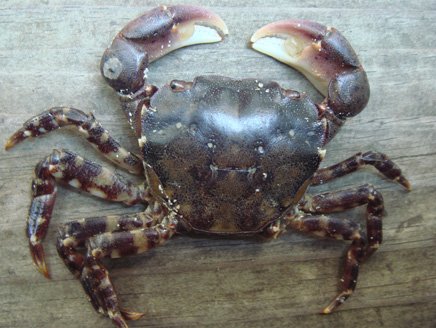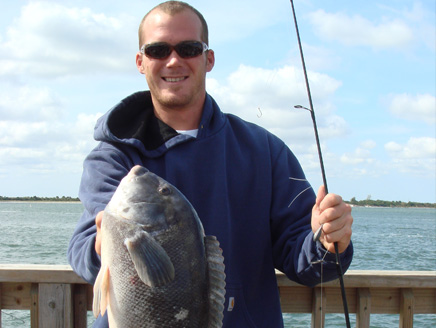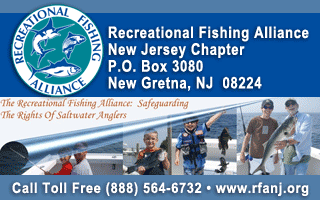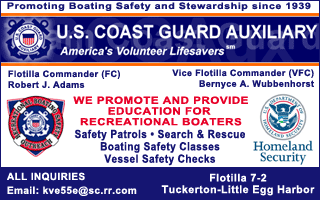
Though Somewhat New to Jersey Waters,
This Crab is Spoiling a Lot of Guys!
Story and Photos by Bob Misak
The "Red Legger"
One of the hottest baits on the jetties is been causing quite a stir here in the northeast from the Carolinas up to Maine. Until now, this has been a well kept secret of the local jetty jumpers...the Asian shore crab. Affectionately named "red legger" by the locals who have been catching fish on them for up to ten years now, these resilient little bait crabs are easily obtained, last for days in captivity, and are used only to catch crustacean feeding fish. Although the USDA and many marine biologists semm concerned about this invasive species, the jetty and wreck species like blackfish, triggerfish, sheepsheads, and black drums all forage on these little crabs that make their home amongst the jetty rocks. But how did these crabs remain unnoticed all this time, and how did they even get here? You'll be amazed, or not, to find out that just like the devastastating "gypsy caterpillars" that have plagued our beautiful trees since the 1970's and are still a problem, the shore crab was dropped off here by accident.
 |
| The Asian shore crab is a favorite of the sheepshead. Tog also find the crab to be a favorite food. |
A Bad Mistake...or Not?
The Asian shore crab or "red legger" originally comes from Asia and originally traveled to the shores of the Pacific Northwest as larvae in the bilge of a Japanese cargo ship. After they crossed the ocean from Asia, the "red legger" then established residency in the U.S. along the California coast. In 1988, research scientists and biologists later discovered a small population along the shore of New Jersey, specifically in Townsend's Inlet and Cape May Harbor. They believe it made its home here, after being dumped into New Jersey's ports, again by a wandering cargo ship's water pumping systems, and multiplied from there. But here along the coast of New Jersey this crab didn't just multiply...it grew like a gremlin under water! It soon took off on a breeding mission, and hasn't stopped, and it looks as though it has established itself as a resident, at least along most of the New Jersey coast.
The Asian Shore Crab is considered an invasive species that could impact on other crab species by competing for food and eating crab larvae. They are basically a very hardy crab, even though they only grow to a maximum size of about two to three inches in diameter. They have shown they can survive the relentless winters of both the northeast and the northwest.
 |
| Bob Misak Jr. with a quality tog caught on an Asian shore crab. |
Survival of the Fittest
What would an invasive species such as the Asian shore crab do to establish a pattern of feeding and predator evading to survive in a new world? Let's check out the facts. The asian shore crab also feeds on rock mussels, a food that makes sense for them to target because of the thick, crushing claws that they possess. Another reason is that because they take up residence in rocks, mussels would be one of the only naturally obtained foods for the crab other than bait like bunker and clams that are discarded by fishermen. And because they have been feeding on jetty mussels for so long, many marine biologists have cleverly discovered through research that the rock mussels in New Jersey have actually "naturally thickened" their outer shells in an attempt to fend off the pilfering of their species by the very aggressive red legger crab. In fact some experts believe that since 1988 when these crabs arrived, the rock mussel has almost doubled the thickness of their shells to counteract the attack from the crabs. This seems like it could affect the ecosystem along the east coast and more than likely has, somewhat. But is it a good change or a bad one? If I had to guess, I'd pick B. Let's discuss why, if so, that the Asian shore crab was a blessing in disguise.
Red Leggers...Good or Bad?
As far the Asian shore crab eating too many mussels and causing a decline in the population, it hasn't been proven that these crabs are posing a threat to any other species as of yet. But keep in mind that they've only been here for a little over twenty years, not enough time to make any judgments on anything but the fact that they aren't going away. As far the red legger goes, I think that they are eaten as much, or more than they eat. I have been using shore crabs for bait for years and I have literally caught every type of fish that will chase a crab on them, with the exception of bass. I have caught giant sheepsheads over 10 lbs. on red leggers, as well as triggerfish by the score, (they love them for their small size) and they are quickly becoming the favorite natural bait of the blackfish, or Tautog. A hook can literally be buried inside these crabs, making it undetectable to a master thief like the blackfish. I honestly believe that partly because of the Asian shore crab we have seen obvious increases in the catching of tog and triggerfish further inshore, unlike we have in the past. These crabs are definitely going to change fishing methods in future years, and in some shops around the Point Pleasant and Belmar area you can buy them as bait.
So far there are no real written regulations on the catching and utilization of the Asian shore crab, but increased attention could result in some sort of law regulating their catches. This, like all laws, will probably take a bit of time, giving us the freedom to use these fantastic bait crabs. The Asian shore crab was, therefore a perfectly timed mistake to happen for us here in the northeast part of the country, and New Jersey seems to be the metropolis of the shore crab population! The crab has done very well here with the populations being much higher here than in our northern states, partly due to milder water temps during the winter. I did some personal research on these elusive little creatures, and drove up to the coast of Maine in July 2009 to see what their many rocky coastlines have in terms of shore crab populations. I searched the coast of southern Maine from Bar Harbor to Port Clyde, the southernmost part of the coast. I did not find a single red legger, proving that the population of these crabs starts in New Jersey and basically "fans out" to lower numbers in the surrounding states. But again, this is during a relatively short period of twenty years, so the numbers will grow all along the eastern coast if New Jersey is any indication of the future.
 |
| The elusive triggerfish is also drawn to the Asian shore crab. This beauty tries to escape a New Jersey angler. |
Gettin' in on the Action
Shore crabs are caught a number of ways, and a lot of anglers out on Long Beach Island in South Jersey use a basic bait net with a chunk of pungent meat such as bunker placed inside. They'll leave it down in the jetty rocks and return in a half hour to an hour, sometimes pulling the net up full of crabs. My experience with this method is that it is too "hit or miss". The tide must be perfect to maximize your chances. The method that I use is very simple...good old elbow grease. As a very small person I can slither in between those rocks quite easily. I wait for a half-low, outgoing tide to begin, and then crawl in and flip small rocks, grabbing all the scurrying crabs that emerge from underneath. Filling up both hands with crabs I bring them to the bucket, which should have a nice tight lid, as these crabs are very hearty and are escape artists! Neoprene gloves are highly recommended for this endeavor as I have jammed my hands down on sea urchins, glass, and a few more uncomfortable surprises, such as giant green crabs, which don't take too kindly to being handled...and they hurt too. The shore crabs will move quickly to find another nearby rock to get under, so you should be ready when you flip a rock. Be sure to watch when flipping rocks, as I flipped one over on my finger once and it cost me a thumbnail.
Over the years, my family and I have become very accustomed to using red leggers. They stay on a hook much better than a quartered up green crab, and their size starts at about the size of a dime up to the size of a silver dollar. They are always put on whole because the female has a very tough pad on her underside, making the shore crab very hard for blackfish or other "crustacean connoisseurs" such as triggers and sheepsheads to get them off the hook. In fact, we have become quite accustomed to the tiresome task of collecting red leggers which requires arriving with our empty bait bucket an hour or two early to catch crabs. This has to be done in time to fish the outgoing tides for the big white chins. I have caught tog up to nine pounds off the jetty rocks using large shore crabs, and a ten lb. fish is definitely in my future...especially I am using the "magic crabs".
When are Shore Crabs Available?
Asian shore crabs can be caught from May to October. Then, as the water starts to cool, they begin to thin out. Keep in mind that during the full moon, these crabs (like all others) will shed their shells and become soft. In that state, they are useless as bait. They can be easily ripped off your hook and will cause more aggravation than it's worth. Another note...unlike the green crab, who's legs are trimmed off before hooking, the shore crab can be and should be used with it's legs intact, making it more naturally attractive to the fish that will eat it. This will occasionally "buy you" another hit before you lose the entire crab or hook up with a nice fat white chin!
So if you choose to go catch some "red leggers" make sure you bring an empty bucket and a pair of gloves. You will certainly reap the benefits of a newer, more versatile bait. One last warning...shore crabs, as small as they are, do bite, as most critters that don't want to be handled tend to do. We don't wear gloves at all times when collecting shore crabs, and when put on the hook they should be handled with some finesse. All I know is this; I welcome the red legger to the waters of New Jersey, and hope their population stays this good or gets better. Try them and you might never go back to using greenies! Good luck and great fishing to everyone.















